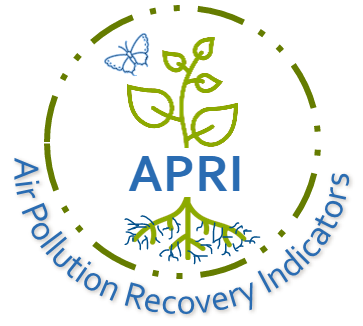Initial research into how habitats and species recover from nitrogen deposition will take place at the Thursley Common which is part of the Defra funded project: Air Pollution Recovery Indicators (APRI).
[Above photo credit: Elena Arrigoni]
Air Pollution Recovery Indicators (APRI) is a Defra funded project that looks at how habitats and species recover from nitrogen deposition. It is being led by Royal Botanical Gardens Kew and is supported by the Joint Nature Conservation Committee, Imperial College London, and the Natural History Museum.
The first phase of the project explores ecosystem recovery on dry heathland from a belowground perspective with a focus on mycorrhizal fungi. Roots of dominant heathland plants, such as the common heather (Calluna vulgaris) form symbiotic associations with ericoid mycorrhizal (ErM) fungi. This association enhances the host plants nitrogen and phosphorous uptake. Nitrogen deposition negatively affects mycorrhizal symbioses and causes nutrient imbalances in the ecosystem.
The decline in nitrogen deposition recorded in the past two decades in the UK poses opens key questions related to whether ecosystems will recover, and how recovery can be assessed. Despite their importance, little is known about how ErM fungi are affected by, and recover from nitrogen pollution, and what their contribution to ecosystem recovery looks like.
Elena arrigoni. Photo credit: jeff duckett
jill kowal and elena arrigoni set up the experiment. photo credit: Jeff Duckett
Initial research will be carried out at Thursley Common where 30 experimental plots will be established. Background nitrogen deposition will be enhanced by adding a nitrogen-based fertiliser in a series of initial pulses. After each fertiliser addition, changes in the ecosystem will be monitored by testing below-ground processes (e.g soil chemistry, fungal community composition, ErM physiology) alongside well-established above-ground indicators (e.g. vegetation physiology, plant chemistry, bryophyte, and lichen cover). The common presence of wildfires and managed burns at Thursley Common also offers the opportunity to investigate the recovery of ErM fungi after fire, and how this recovery might be affected by nitrogen pollution.
There is potential to extend the current research to include further heathland sites in the UK or abroad, and to also study the effects of nitrogen pollution on other terrestrial habitats, such as limestone pavement, and organisms including butterflies and/or moths.
Contact details: rachael.howlett@jncc.gov.uk





